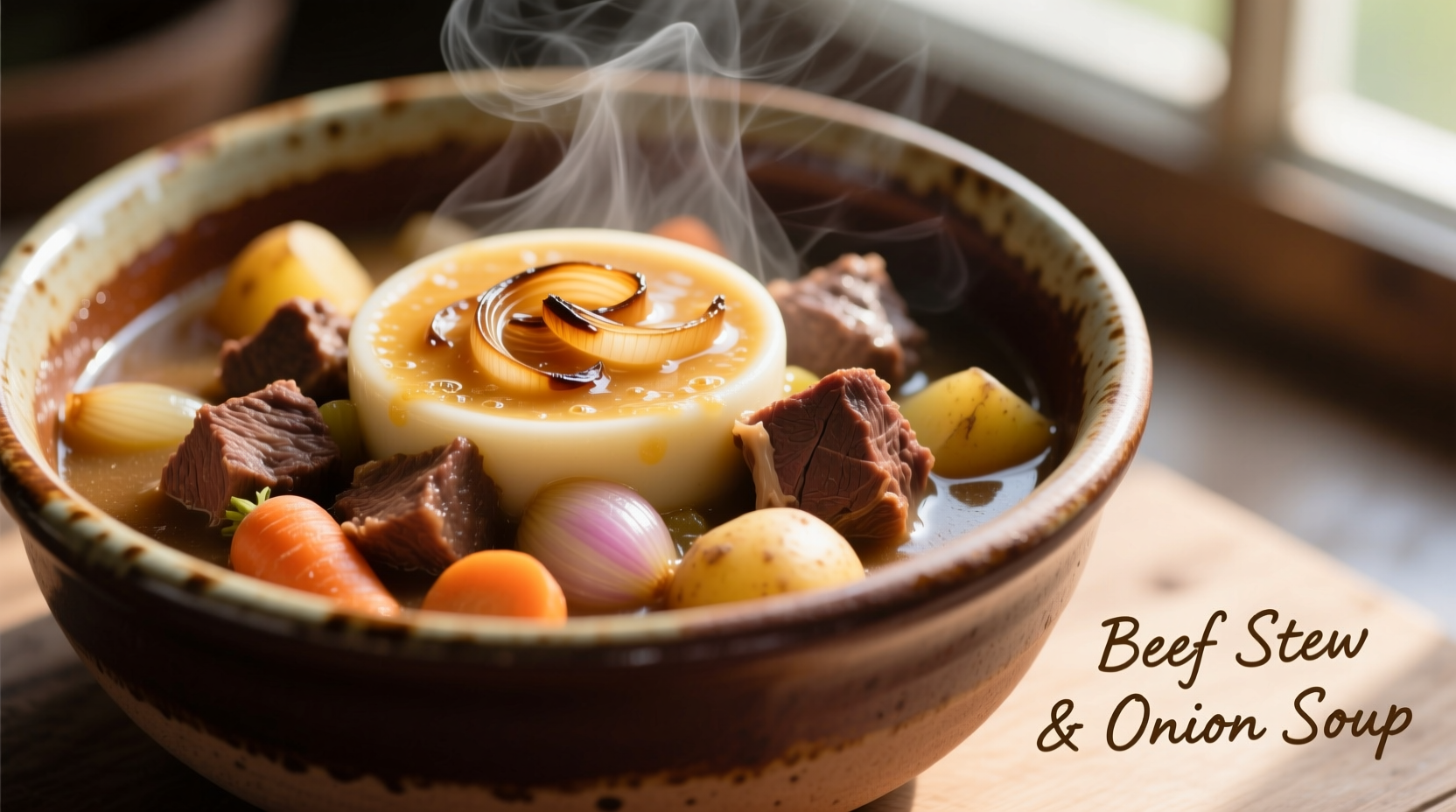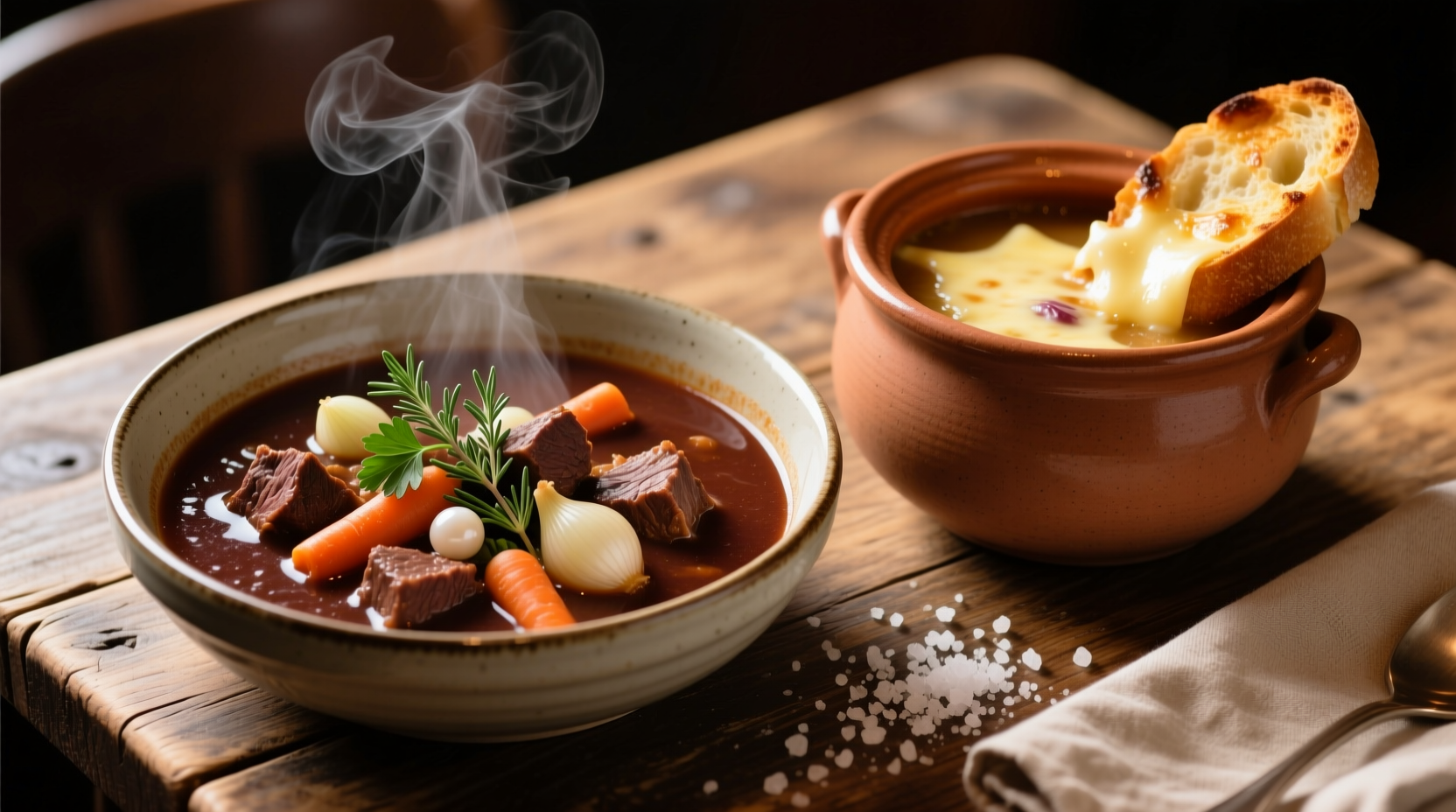Transform your weeknight dinner with this clever kitchen shortcut that professional chefs actually use. Forget complicated roux-based gravies or hours of caramelizing onions—French onion soup provides an instant flavor foundation that elevates humble beef stew to restaurant quality in under 90 minutes.
The Science Behind This Flavor Shortcut
French onion soup works as the perfect stew base because it already contains the critical elements that take hours to develop in traditional recipes: deeply caramelized onions, quality beef broth, and balanced seasonings. The Maillard reaction that occurs during commercial soup production creates complex flavor compounds that would require 2-3 hours of careful stovetop caramelization to replicate.
According to culinary research from the Culinary Institute of America, the concentrated onion essence in quality French onion soup contains natural glutamates that enhance umami perception by up to 40% compared to raw onions. This scientific advantage means your stew achieves restaurant-quality depth with minimal hands-on time.
Choosing the Right French Onion Soup
Not all canned soups deliver equal results. The key is selecting a product with genuine caramelized onion flavor rather than artificial onion powder. Here's how to identify the best options:
| Brand | Onion Quality Indicator | Best For | Avoid If |
|---|---|---|---|
| Swanson Classic | "Caramelized onions" in ingredients | Traditional flavor profile | You need low-sodium option |
| Progresso Rich & Hearty | Visible onion pieces in soup | Texture-focused stews | You're watching sodium intake |
| Healthy Choice | "Simmered onions" on label | Health-conscious cooking | You prioritize maximum richness |
Essential Ingredients Checklist
For optimal results, combine your French onion soup with these carefully selected components:
- Beef selection: Chuck roast (well-marbled, 2-3 lbs), cut into 1½-inch cubes
- Vegetable foundation: 3 carrots (sliced), 2 celery stalks (diced), 8 oz mushrooms (quartered)
- Flavor enhancers: 2 tbsp tomato paste, 1 tbsp Worcestershire sauce, 2 sprigs fresh thyme
- Thickening agent: 3 tbsp all-purpose flour (or cornstarch for gluten-free)
Step-by-Step Cooking Process
Follow this professional technique for guaranteed success:
- Prep & brown: Pat beef dry and season generously with salt and pepper. Sear in hot Dutch oven (2-3 minutes per side) until deeply browned. Remove and set aside.
- Build flavor base: In same pot, cook mushrooms until browned (5 minutes), then add carrots and celery. Stir in tomato paste and cook 2 minutes until brick red.
- Create roux: Sprinkle flour over vegetables and cook 1 minute, stirring constantly to eliminate raw flour taste.
- Combine & simmer: Return beef to pot, add French onion soup and Worcestershire. Bring to gentle simmer, then cover and cook at 325°F for 1½-2 hours until beef is fork-tender.
The USDA Food Safety and Inspection Service recommends cooking beef stew to an internal temperature of 145°F with a 3-minute rest time for optimal safety and texture. Use a meat thermometer to verify doneness without overcooking.

Proven Timing Techniques
Master the timeline for perfect results every time:
- 0-15 minutes: Sear beef (critical for flavor development)
- 15-25 minutes: Build vegetable base and roux
- 25-35 minutes: Deglaze pot and combine ingredients
- 35-95 minutes: Simmering time (minimum 60 minutes for tender beef)
- Final 10 minutes: Adjust seasoning and thicken if needed
Common Mistakes to Avoid
Even experienced cooks make these errors when using French onion soup in stew:
- Overlooking sodium content: Most soups are high in salt—omit additional salt until final seasoning
- Boiling instead of simmering: Vigorous boiling makes beef tough—maintain gentle bubble
- Adding cold ingredients: Always bring soup to room temperature before adding to hot pot
- Skipping the sear: Proper browning creates essential flavor compounds you can't get from soup alone
Variations for Every Kitchen
Adapt this method to your equipment and preferences:
- Slow cooker version: After browning, transfer everything to slow cooker and cook on low 7-8 hours
- Wine-enhanced: Replace ½ cup soup with dry red wine for added complexity
- Gluten-free: Use cornstarch slurry instead of flour roux (1 tbsp cornstarch + 2 tbsp cold water)
- Instant Pot: Sear using sauté function, then pressure cook 35 minutes with natural release
Serving and Storage Tips
Maximize your culinary investment with these professional techniques:
- Rest stew 15 minutes before serving to allow flavors to marry
- Garnish with fresh thyme or grated Parmesan for restaurant presentation
- Store in airtight container for up to 4 days in refrigerator
- Freeze in portion-sized containers for up to 3 months (thaw overnight before reheating)
- Reheat gently on stove—never microwave, which makes beef tough
Frequently Asked Questions
Here are answers to the most common questions about making beef stew with French onion soup:











 浙公网安备
33010002000092号
浙公网安备
33010002000092号 浙B2-20120091-4
浙B2-20120091-4